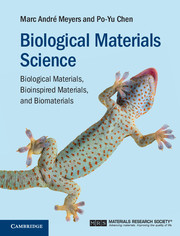Book contents
- Frontmatter
- Epigraph
- Contents
- Preface
- List of Boxes
- 1 Evolution of materials science and engineering: from natural to bioinspired materials
- Part I Basic biology principles
- Part II Biological materials
- 6 Silicate- and calcium-carbonate-based composites
- 7 Calcium-phosphate-based composites
- 8 Biological polymers and polymer composites
- 9 Biological elastomers
- 10 Biological foams (cellular solids)
- 11 Functional biological materials
- Part III Bioinspired materials and biomimetics
- References
- Index
10 - Biological foams (cellular solids)
from Part II - Biological materials
Published online by Cambridge University Press: 05 August 2014
- Frontmatter
- Epigraph
- Contents
- Preface
- List of Boxes
- 1 Evolution of materials science and engineering: from natural to bioinspired materials
- Part I Basic biology principles
- Part II Biological materials
- 6 Silicate- and calcium-carbonate-based composites
- 7 Calcium-phosphate-based composites
- 8 Biological polymers and polymer composites
- 9 Biological elastomers
- 10 Biological foams (cellular solids)
- 11 Functional biological materials
- Part III Bioinspired materials and biomimetics
- References
- Index
Summary
Introduction
Many biological structures require light weight. The prime examples are birds, whose feathers, beaks, and bones are designed to maximize performance while minimizing weight. Other examples are plants, where the same requirements operate. Figure 10.1 illustrates two examples of structures designed to have significant flexure resistance.
Plant stalks are composed of cellulose and lignin arranged in cells aligned with the axis of growth. The giant bird-of-paradise stem is lightweight and has a structure consisting of cells which have, on their longitudinal section, a rectangular (but interconnected in a staggered manner) shape (Meyers et al., 2013) (Fig. 10.1(a)). The cross-sectional shape is closer to elliptical. Thus, the cells have a cylindrical shape. If we look at the cell walls at a greater magnification, we observe that they are also cellular. This produces two levels of cellular structure, in a manner akin to the feather rachis in Falco sparverius, presented in Chapter 2 (see Fig. 2.1). The solution often found in nature is to use tailored structures to address the stress demands. The structure is designed to resist flexure stresses without buckling.
- Type
- Chapter
- Information
- Biological Materials ScienceBiological Materials, Bioinspired Materials, and Biomaterials, pp. 397 - 451Publisher: Cambridge University PressPrint publication year: 2014



